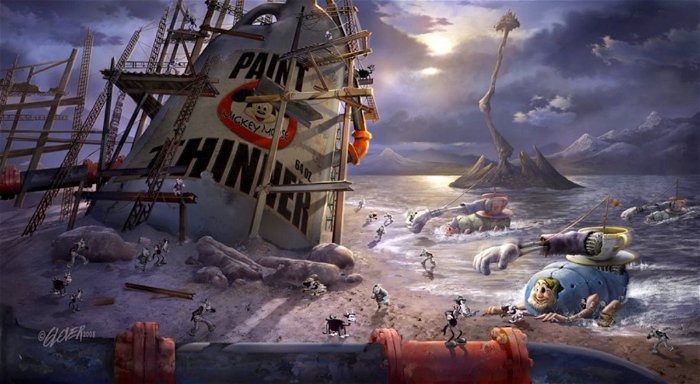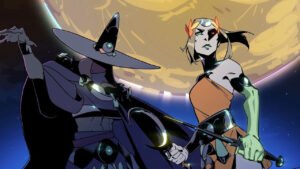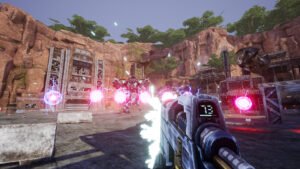In the year 2028, Mickey Mouse will have been entertaining children for 100 years. That means the mouse that built an entertainment empire has already been hard at work for 82 years. He’s become a generational pop culture, and even if he’s been no stranger to video games in that time, his latest outing is something of a departure. There’s an unfamiliar scent of risk in the air when you look at Epic Mickey a Wii-exclusive platformer published by Disney Interactive and created by, of all people, Warren Spector, the man that gave the world dark, brooding games like Thief: The Dark Project and Deus Ex. It’s a bold direction to take Mickey Mouse, but surprisingly, it’s not a new one.
This Is Your Great Grandfather’s Mouse
Although we know the Mickey of today as a squeaky-clean, almost sanitized icon, the original Mickey was closer to contemporary cartoon characters such as Bart Simpson or the kids of South Park. He was a feisty, mischievous character that was not above playing pranks or getting in a fight, even though his heart was in the right place.
It is this older, edgier Mickey that greets players in Epic Mickey, and he’s gotten himself into trouble. Thanks to an accident involving paint, turpentine and a model of a theme park on the table of the Wizard Yen Sid, Mickey is pulled into a mysterious place known as the Cartoon Wasteland. Here, old, irrelevant or rejected cartoon characters and theme park ideas are slowly being conquered by Mickey’s blunder, now known as The Phantom Blot.

The game itself is a platformer, an increasingly rare genre in today’s gaming landscape. Mickey runs, jumps, and has two weapons, “Tint” and “Turp”, which are paint and turpentine respectively. Both weapons can affect both characters populating the wasteland as well the environment itself. Mickey can dissolve enemies and even portions of the landscape with Turp, and similarly he can convert enemies to his cause or re-construct areas by applying enough Tint. Over the course of his adventure he will travel to several “hub worlds” that start as the jumping off point for visits with various characters and even distorted versions of theme parks that have built up like a coral reef over the long life of the Disney Studios. Chief among these is Oswald Rabbit, his half-brother that has become psychotically enraged over the success of Mickey over the years.
Where the game begins to distinguish itself from other platformers is the clear Spector influence of his previous game Deus Ex where multiple solutions existed to solving problems. For example, in the demonstration shown, Mickey was given a side-quest where a character in a shop requested that Mickey retrieve four Tiki Masks scattered around the area. The classic Mickey of today that people are familiar with would—and could—dutifully collect the masks as asked and turn them in for a reward. However, another, sneakier option is available, and this was the solution demonstrated, as Mickey collected only one mask and gave it to the “quest-giver”. The mask was then placed in a back room and Mickey left the shop, only to make his way to the rear, use Turp to dissolve the back wall, enter the storage room and steal back the mask, making his way back to the font to try and pass it off as new item. He managed to succeed in this instance, but it was revealed that he can be “caught in the act” and the way he treats other characters is tracked by a “morality meter” with denizens of the world reacting favourably or unfavourably to Mickey, based on his treatment of others.

Paths & Possibilities
While Mickey is never outright evil, Spector differentiates the two modes of behaviour as “The Hero” and “The Scrapper.” This series of branching alternatives is not limited just to his ethics. Mickey’s use of Turp or Tint can mean the difference between gathering allies to fight for your cause, or bypassing certain encounters entirely. Like Deus Ex there are possibilities for multiple styles of play, from flat out destructive, through liberal use of Turp to destroy enemies, to sneaky alternatives where Mickey can use objects like televisions to distract foes long enough for him to sneak by without ever being noticed.
Traveling the various worlds is similarly not as straightforward as it is in other games. Rather than simply navigate an “overworld” map or menu system to pick destinations, Mickey must traverse “transition” levels that hearken back to traditional 2D side-scrolling platform games of ages past. The level demonstrated showed Mickey having to make his way through a loving recreation of Steamboat Willie, one of Mickey’s earliest appearances, except now the black and white short subject could be navigated by jumping over cows, grabbing in-game objects and generally “playing Mario” with one of the oldest pieces of animation in the history of cinema.
Another surprising quality of the game is that the cut-scenes that appear in the game make a startling transition to traditional, 2D animation. Flying in the face of conventions established by powerhouses such as Square-Enix, when Mickey encounters an important character or moment, the 3D, polygonal environments of the game are replaced by hand-drawn animation to reflect the heritage of both the game and the character. It’s an unexpected, but logical choice.
Epic Mickey is shaping up to be one of the most unusual titles of the year, not just on the Wii, but on any platform. While there are still a few months to go before the game’s November 1
release, there’s already a fair amount of polish and some unconventional design choices on display. Perhaps the most surprising thing of all is that the game’s central concept has the blessing and financial backing of the Disney Corporation itself. Their most sacred cow is being allowed to cut loose, be mischievous and even be violent after decades of being side-lined as the ultimate Goody Two-Shoes. The final result, if nothing else, should be interesting.




